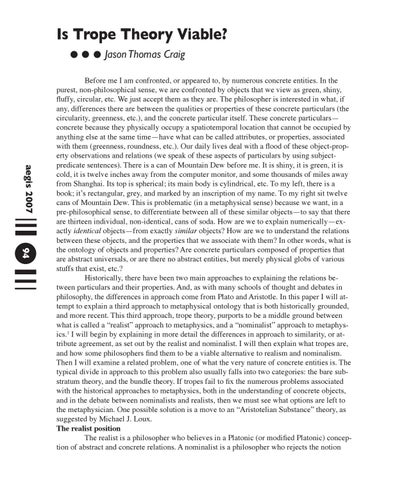Is Trope Theory Viable? Jason Thomas Craig
aegis 2007 94
Before me I am confronted, or appeared to, by numerous concrete entities. In the purest, non-philosophical sense, we are confronted by objects that we view as green, shiny, fluffy, circular, etc. We just accept them as they are. The philosopher is interested in what, if any, differences there are between the qualities or properties of these concrete particulars (the circularity, greenness, etc.), and the concrete particular itself. These concrete particulars— concrete because they physically occupy a spatiotemporal location that cannot be occupied by anything else at the same time—have what can be called attributes, or properties, associated with them (greenness, roundness, etc.). Our daily lives deal with a flood of these object-property observations and relations (we speak of these aspects of particulars by using subjectpredicate sentences). There is a can of Mountain Dew before me. It is shiny, it is green, it is cold, it is twelve inches away from the computer monitor, and some thousands of miles away from Shanghai. Its top is spherical; its main body is cylindrical, etc. To my left, there is a book; it’s rectangular, grey, and marked by an inscription of my name. To my right sit twelve cans of Mountain Dew. This is problematic (in a metaphysical sense) because we want, in a pre-philosophical sense, to differentiate between all of these similar objects—to say that there are thirteen individual, non-identical, cans of soda. How are we to explain numerically—exactly identical objects—from exactly similar objects? How are we to understand the relations between these objects, and the properties that we associate with them? In other words, what is the ontology of objects and properties? Are concrete particulars composed of properties that are abstract universals, or are there no abstract entities, but merely physical globs of various stuffs that exist, etc.? Historically, there have been two main approaches to explaining the relations between particulars and their properties. And, as with many schools of thought and debates in philosophy, the differences in approach come from Plato and Aristotle. In this paper I will attempt to explain a third approach to metaphysical ontology that is both historically grounded, and more recent. This third approach, trope theory, purports to be a middle ground between what is called a “realist” approach to metaphysics, and a “nominalist” approach to metaphysics.1 I will begin by explaining in more detail the differences in approach to similarity, or attribute agreement, as set out by the realist and nominalist. I will then explain what tropes are, and how some philosophers find them to be a viable alternative to realism and nominalism. Then I will examine a related problem, one of what the very nature of concrete entities is. The typical divide in approach to this problem also usually falls into two categories: the bare substratum theory, and the bundle theory. If tropes fail to fix the numerous problems associated with the historical approaches to metaphysics, both in the understanding of concrete objects, and in the debate between nominalists and realists, then we must see what options are left to the metaphysician. One possible solution is a move to an “Aristotelian Substance” theory, as suggested by Michael J. Loux. The realist position The realist is a philosopher who believes in a Platonic (or modified Platonic) conception of abstract and concrete relations. A nominalist is a philosopher who rejects the notion





